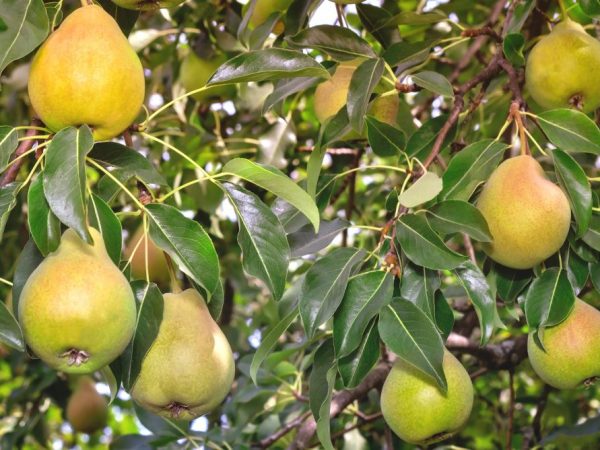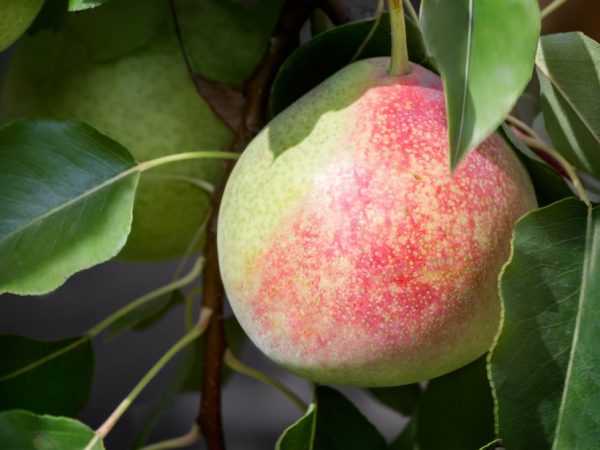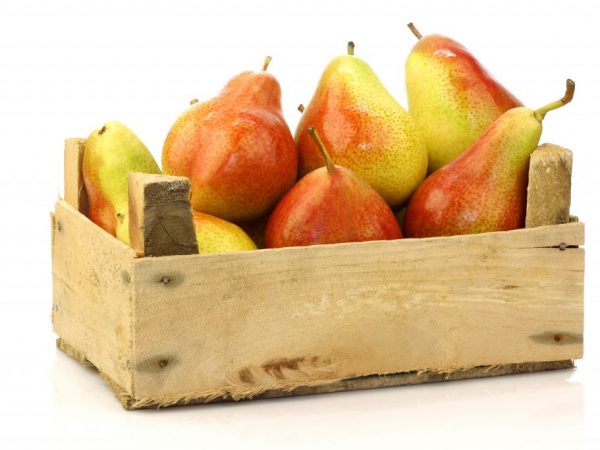Characteristics of Elena pear varieties
The Elena pear variety is characterized by excellent productivity. The tree is easy to care for. The variety is valued for its large fruits that can be transported.

Characteristics of Elena pear varieties
Characteristics of the variety
The pear variety Elena belongs to the early winter. The first fruiting occurs 6-7 years after planting. The pear is self-pollinated.
Description of the tree
The description shows that the trees of this species are medium-sized. The maximum height is 3-4 m.
Crohn of slight density, compressed pyramidal shape. Easily tolerates spring frosts.
Elena pear blossoms and bears fruit every year in all weather conditions. The tree is immune to various diseases, especially fungal.
Description of fruits
Fruits of regular shape, medium to large. During the growing season, they reach weight of 150-210 g.
The harvest period falls in the third decade of September. With the correct collection of fruits, they retain their commercial qualities until mid-winter.

Fruits are yellow with a red blush
The description of the fetus includes the following characteristics:
- rounded pear-shaped with a tuberous surface;
- the peduncle is short, but dense and slightly curved;
- fully ripe fruit has a bright yellow rind with a red blush;
- light pinkish blush is inherent;
- grayish blotches all over the peel;
- the taste is sweet and sour with subtle notes of astringency;
- moderately pronounced spicy aroma;
- the pulp is juicy and slightly oily, with a dense consistency of white.
The fruits are stored in a dark and cool place for 4-5 months.
Elena's pears are suitable for fresh consumption. Used for making jams, a variety of twists, making marmalade, marshmallow, wine, compotes, juices.
Care
Timely watering, feeding, pruning will allow you to get tasty and healthy fruits.
Sapling selection
Characteristics of good planting material:
- the presence of living buds and flexible branches;
- absence of signs of disease and damage on the young shoot;
- the roots should be moderately moist;
- well-grown root system.
Drop off location
The second important task is to decide on the landing site. The landing site should be well lit and protected as much as possible from gusty winds.
The trees of this fruit do not tolerate moisture stagnation. It is necessary to protect the plant from water as much as possible by building good drainage.
The soil
Dense clay soils are not suitable for planting varieties Elena due to the high moisture content. Better to prepare black soil or fertile loam. Due to good air circulation, the access of nutrients to the root system of the plant will become free.
Pit
The pit for planting should have a depth of up to 1 m, a diameter of at least 0.5 m. A fertile mixture is poured onto the bottom, which is prepared from garden soil, peat, humus and sand, and the roots are distributed over the entire width and height. This will allow not to deepen the root collar.
Weed cleaning
Cleanliness in the barrel circle is important. Weeds and fallen leaves are removed periodically. It is customary to burn fallen leaves in order to destroy the pests that winter in them.
This will give an aesthetic appearance to the landing site. Will prevent deformation of the root system.
Watering
This type of pear loves watering. Water consumption directly depends on the amount of natural precipitation and the age of the plant.
It is better to carry out sprinkling. And in the hot season, abundant watering will be required. On average, this is 2-3 buckets for one tree.
Irrigation
Irrigation of the ground at the trunk is carried out in several stages. The first is when the tree is in bloom, the second is when the first green leaves appear. The last stage is during the laying of the kidneys for the next year.
They irrigate the ground within a radius of half a meter from the trunk. Leave a small hole in a circle.

Timely watering, feeding, pruning will allow you to get a good harvest
Pruning
Pruning should be done in the spring before growth is activated. Removing old, sick and damaged shoots from the trunk, thin out the crown. They also increase air circulation between the branches.
It is also necessary to remove branches with dried flowers and buds. Since young shoots can give a full harvest, this serves the uniform development of fruits.
Treatment
Elena trees are treated with fungicides in the spring to strengthen immunity against diseases and pests. For each season, there are special categories of fertilizers for feeding:
- in the spring - organic and nitrogen fertilizers;
- in summer - potash feed;
- in the autumn - phosphorus complexes.
Using prophylactic agents can help keep pests out and keep yields good. But use with caution and do not let chemicals come into contact with the tree trunk, they will cause burns.
Pests and diseases
The description shows that the hybrid variety Elena is resistant to some diseases. Septoria and scab are rarely affected by this species. But with insufficient preventive measures, such diseases arise:
- rust;
- fruit rot;
- black cancer;
- powdery mildew.
Pests often cause harm to such a fruit tree:
- leaf roll;
- pear mite;
- leafy fleas;
- green aphid.
They spoil the leaves and fruits of the pear.
The main methods of struggle:
- spray the sprouts until the buds appear with solutions from natural ingredients;
- burn fallen leaves immediately;
- destroy plant parts affected by pests and spoiled fruits;
- dig up trunks, etc.
Proper care and preventive actions will protect the pear tree from pests.
Conclusion
The pear variety Elena is chosen by many gardeners for planting on their plots, since the tree bears fruit every year, and the fruits are stored for a very long time.


